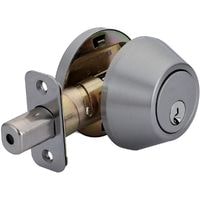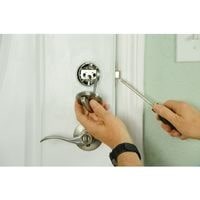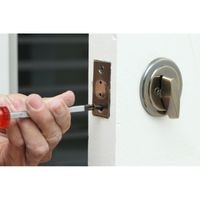How to Remove a Deadbolt Lock. Removing a deadbolt is a relatively straightforward process in which you’ll remove the old lock and install a new one.
The whole process should take no more than 15-20 minutes, depending on the number of doors being replaced and what type of door they are.
For example, if you’re replacing an exterior door with a reinforced metal door, as opposed to an interior wooden paneled door.
You may need to purchase a different type of deadbolt to accommodate the extra weight that comes with installing it on a stronger surface.
How to Remove a Deadbolt Lock

Some deadbolts include a decorative rose plate that gives your hardware greater visual appeal.
The decorative piece of hardware also serves the purpose of covering up mounting screws that would otherwise be visible.
Whether you’re replacing or repairing a locking mechanism, it’s usually helpful to know how to remove such a decorative plate in order to access and replace the internal parts of the door handle or bolt itself.
This can help save time during your project and makes it easier on you in the long run.
Follow our simple steps to replace and remove a deadbolt lock.
Take off the Rose Plates
To remove the old lock on your door, you will first want to remove the doorknob and get rid of the screws in the process. (Doing this will make sure that the screws don’t get into your way later.)
Next, take out a Phillips-head screwdriver or driver and unscrew both rose plates visible at the top of your doors.
Once both screws are removed, open up your door to access each side of the deadbolt assembly and retract them from each side as well.
Disconnect the Latch Assembly
To remove the door latch, use a Phillips screwdriver or driver to unscrew the two screws that keep it in place. The top hole is for turning clockwise and the bottom one is counterclockwise.
If you have stuck screws, first use your screwdriver to lever them out – or replace them with screws that come out easily otherwise they may break while you’re trying to remove them.
Fix the New Latch Assembly

Now you can change out your deadbolt for a new one. You will perform this installation in the opposite order of how you removed it, which means installing the cam last.
For a door, the cam is an assembly that turns when the doorknob is turned and actuates a locking mechanism.
Assemble the latch first, making sure to place it in line with the center of your door’s circular hole so that it stays steady throughout the lifetime of your lock.
From there, if either end of your latch isn’t falling in this position, turn your cylinder till they are evenly aligned or vice versa if either end is too far off-center.
Second, the latch assembly faceplate should fit flush with the door. If it doesn’t sit flush, you will need to take out some wood from underneath the area that’s giving a gap between the door and its surface by outlining or outlining too much.
Counteract this by cutting extra wood, making sure that you don’t remove too much and end up slicing the faceplate itself.
Make sure you remove enough wood so the faceplate rests at the appropriate depth, keeping everything flush with the door’s surface.
Once the lamp functions as it should and is not damaged after installation of all components in this case adding a small hinge to allow for storing objects on top of it secure it using screws.
Deadbolt Cylinder Installation
Take the deadbolt cylinder that has the cam bar insert it into the door and make sure it slides smoothly.
Set up the Rose Plate
The deadbolt rose plate should be positioned on the opposite side of the circular hole, aligned with the hole. In the case where it’s 14 inches smaller, sand it down and then add two coats of paint.
You should be able to slide it onto the cam bar smoothly. Ensure a smooth return process by allowing it to completely dry before continuing.
Turn the cylinder upside down to check if there is an adjustable locking mechanism that allows you to increase or decrease the extension from its original position.
This mechanism can be adjusted to provide greater security and ease of unlocking if you experience slipping motions within the deadbolt once the deadbolt is installed in its final position.
how to remove a deadbolt lock
Related Guides
